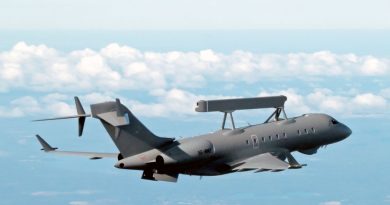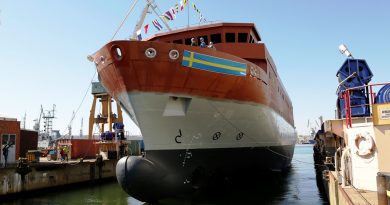IMDEX 2023 – Singapore provides first details on new Multi Role Combat Vessel
First details about the design and equipment of the Republic of Singapore Navy (RSN) new Multi-Role Combat Vessel (MRCV) emerged at IMDEX 2023. On March 22, Singapore’s Defence Sciences and Technology Agency (DSTA) and Saab of Sweden signed a Memorandum of Understanding (MoU) on the sidelines of the Singapore Defence Technology Summit.
Aside the partnership implemented initiative in the three domains of long-term supportability, people development and smart technologies, the DSTA and Saab will co-develop and design the RSN new MRCV, “harnessing technologies such as artificial intelligence (AI) and data analytics to realize the MRCV’s concept as highly digital ship”, the joint statement between the two parties reports.
Saab Kockums, received by DSTA as the MRCV project manager and system integrator, a contract for the basic design of the new class of vessels. This sees the involvement of Odense Maritime Technology (OMT) of Denmark that was responsible for the design of the Danish Navy’s Iver Huitfeldt-class frigates and is part of the team of the Type 31 frigate programme.
On the same day of the signing of the MoU between DSTA and Saab, the Republic of Singapore Ministry of Defence announced the award of a contract to ST Engineering for the detailed design and construction of the MRCV which programme will see the delivery of six platforms to replace the existing Victory-class Missile Corvettes (MCVs) in the RSN. The MRCVs will be delivered progressively, according to the MINDEF, from 2028 onwards.
In addition to being a combat platform, the MRCV is designed to function as mothership and can operate a range of manned and unmanned systems in a flexible, intuitive, and integrated manner. The MRCV will be able to support a wide spectrum of missions with maximum combat effectiveness.
No official statement emerged during IMDEX 2023, but according to the few information released, Saab and OMT were engaged to provide the basic design by the end of 2023, before ST Engineering will launch the detailed activities in 2024 and later the construction.
The relationship between Saab and the DSTA date back to the late 80s and saw the Swedish industry to provide Singapore with the basic design of the Indipendence-class Littoral Mission Vessels (LMVs) as well as the composite-made superstructures for the same vessels that were built by ST Engineering Marine. Saab, together with the Swedish industry, also provided submarines belonging to the in-service Archer- and previous Challenger-classes directly provided by Sweden to the Singapore MoD and Navy.
EDR On-Line understood that ST Engineering Marine is already involved in the basic design phase, being responsible for the procurement and integration of the platform equipment and MINDEF furnished equipment and the undertaking of design and the provision of the Integrated Logistics Support Engineering to ensure operational readiness during the lifespan.
Although ST Engineering hasn’t commented or confirmed, the Singapore company is expected to provide the key mission equipment that will be embarked on the ship: the unmanned package of surface, aerial and underwater vehicles and their command and control that will put the new vessels at the edge in terms of advanced technologies. ST Engineering has matured unmanned know-how in the past and today is marketing it worldwide, namely the Venus family of vehicles and their Autonomast suite to convert a manned into an unmanned platform. The Singapore group is also expected to incorporate Artificial Intelligence (AI) applied to combat systems and the evolution of platform management system, data analytics, integrated in-service support and fleet management that it developed and continues to evolve. All this automation and smart solutions will have an influence on a considerable crew reduction.
In addition to the first programme details, two computer images were released taken from a video that was running at the Saab stand during IMDEX 2023.
The images show a platform derived from the Iver Huitfeldt-class frigates for the Danish Navy with an advanced stealthy design. The superstructures are divided into blocks were the front one featuring and resembling an integrated mast with at least one four phased array main radar and other sensors and antennas, while the stern block incorporates the hangar and the propulsion funneling. Between them we find an area that should be conceived to accommodate anti-ship missiles and other modular mission equipment, masked on the sides to ensure stealthness. Another modular mission area is located underneath the stern flight deck and aviation facilities and according to images released it accommodates two sterns launch and recovery stations for large RHIB-sized craft and unmanned platforms. The drawings show hangar facilities for both manned rotary-wing platform (in the form of Airbus Helicopter Cougar and Lockheed Martin Sikorsky SH-60 Sea Hawk helicopters and exhibited with accommodation for a single platform) together with air unmanned systems. The bow is characterized by a gun and vertical launching systems for surface-to-air missiles.
The Ministry of Defence and the RSN also unveiled a few details on the selected OEMs for what was indicated as the self-defence capability. It was specified the participation of Thales, MBDA and Leonardo, without providing specifics. However, the ship drawings show the Leonardo 76/62 mm Super Rapido in the Strales configuration for the use of DART guided ammunitions, enhancing both the surface and air defence of the platform especially against missile and asymmetric threats. Regarding the missiles package, no indication was provided but EDR On-Line understood that the new MRCV will be equipped with both the Aster and VL MICA family of missiles. The RSN already has in its inventory both type of missiles respectively on board Formidable-class frigates and Independence-class LMVs. Although MBDA hasn’t confirmed or commented, the fact that the missile company was showing in a corner of its stand the VL MICA and Aster VLSs together, helped to have an idea of the potential configuration.
The future customer also confirmed Thales as supplier of the new programme, and the French group corroborated it adding they will provide a new multifunction radar without giving additional details and information also on other potential equipment for the new ships. The large fixed faces of the main ship mast could better indicate the installation of the Sea Fire new generation AESA multi-function radar, capable to conduct the whole range of maritime mission including the ballistic missile defence.
Photos courtesy ST Engineering and L. Peruzzi






